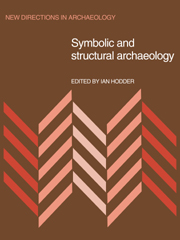Book contents
- Frontmatter
- Contents
- List of contributors
- Preface
- Part one The development of theory
- Part two The search for models
- 5 Matters material and ideal
- 6 House power: Swahili space and symbolic markers
- 7 The interpretation of spatial patterning in settlement residues
- 8 Decoration as ritual symbol: a theoretical proposal and an ethnographic study in southern Sudan
- 9 Structures and strategies: an aspect of the relationship between social hierarchy and cultural change
- 10 Mortuary practices, society and ideology: an ethnoarchaeological study
- Part three Application: the analysis of archaeological materials
- Part four Commentary
- Index
8 - Decoration as ritual symbol: a theoretical proposal and an ethnographic study in southern Sudan
Published online by Cambridge University Press: 27 February 2010
- Frontmatter
- Contents
- List of contributors
- Preface
- Part one The development of theory
- Part two The search for models
- 5 Matters material and ideal
- 6 House power: Swahili space and symbolic markers
- 7 The interpretation of spatial patterning in settlement residues
- 8 Decoration as ritual symbol: a theoretical proposal and an ethnographic study in southern Sudan
- 9 Structures and strategies: an aspect of the relationship between social hierarchy and cultural change
- 10 Mortuary practices, society and ideology: an ethnoarchaeological study
- Part three Application: the analysis of archaeological materials
- Part four Commentary
- Index
Summary
Relationships between the use of decoration and particular dimensions of social action are examined in Braithwaite's paper. A suggestion is made that covert forms of discourse, such as decoration, may express messages that are inconsistent with the legitimation of relationships of power. Through a study of the Azande of Sudan, it is shown that decoration occurs on objects that through their use involve encounters between opposed categories. Amongst the Azande the male/female dichotomy is particularly marked and the maintenance of this opposition, and of the dominant position of men, is problematical. The position of women is subordinate, but extremely powerful and certain ideological and ritual strategies are required to maintain the separation of the sexes and the dominant position of men. Items that through their use involve, either directly or indirectly, encounters between male and female are marked out with decoration, and it is suggested that decoration both covertly expresses and authorises the encounter between these opposed categories. Yet not all dichotomies between groups of people in Azande society require this form of ritual strategy. The study also shows that decoration may not be used on items involving opposed categories where other ideological strategies are employed to maintain the relationship of power. Through different kinds of ideological and ritual mechanisms the social order may be maintained, and also transformed.
This paper presents the results of an investigation into the contexts of decoration within the material culture and the social and cultural forms of some of the Azande people of southern Sudan.
- Type
- Chapter
- Information
- Symbolic and Structural Archaeology , pp. 80 - 88Publisher: Cambridge University PressPrint publication year: 1982
- 33
- Cited by



